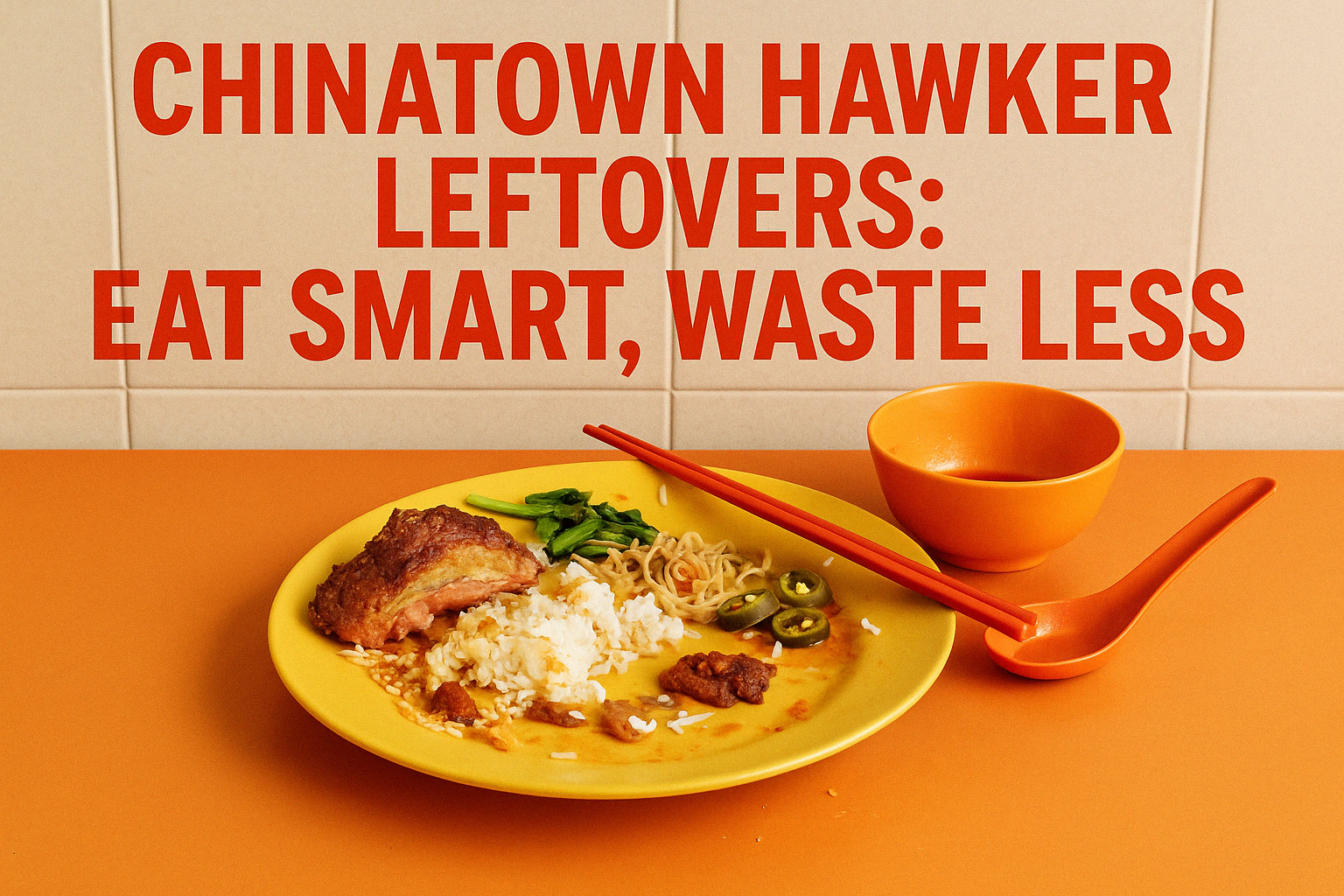
Raising awareness through visuals: smart ways to enjoy hawker food while reducing waste
Introduction
Why Hawker Leftovers Matter Today

In today’s world of rapid consumption and increasing food waste, the conversation around hawker leftovers has taken center stage. Particularly in vibrant places like Chinatown, where food is deeply embedded in the culture, leftovers from hawker stalls represent more than just discarded meals—they signify an urgent need for sustainable practices. With food costs rising and environmental pressures growing, reducing and reusing hawker leftovers is both a personal responsibility and a community imperative. The good news? Many are starting to realize that what was once wasted can be transformed into a valuable resource. From chefs to eco-conscious citizens, a movement is underway to shift our mindset from disposal to mindful consumption. Eating smart and wasting less not only saves money but also helps support local vendors and the planet.
Exploring Chinatown’s Food Culture
Chinatown is a culinary haven, known for its rich tapestry of flavors, aromas, and traditional street food. From sizzling noodles to spicy satays, the bustling hawker stalls cater to both locals and tourists, creating a melting pot of culture and cuisine. But behind the delicious dishes lies a mounting issue—food waste. The same energy that fuels Chinatown’s culinary success also leads to significant volumes of uneaten food. Understanding the deeply rooted food traditions, seasonal specialties, and daily operations of these hawker stalls is crucial to addressing the issue of leftovers. Food is a form of pride here, and any initiative to reduce waste must respect this cultural context. This is where innovation, community collaboration, and education come into play.
Understanding Hawker Leftovers
What Are Hawker Leftovers?
Hawker leftovers refer to the uneaten food that remains after a day of selling at food stalls. These can range from fully prepared meals that go unsold to half-eaten dishes abandoned by customers. While some vendors make small batches to minimize waste, others, especially those dealing with unpredictable foot traffic, may end up with surplus. These leftovers are often still safe for consumption but get discarded due to hygiene concerns, lack of storage, or strict food regulations. In many cases, leftovers also include ingredients that have been prepped but not used. Identifying what qualifies as a leftover and assessing its usability is the first step toward creating a sustainable solution.
Daily Waste Volumes from Hawker Stalls
Across Chinatown’s bustling hawker centers, daily food waste can amount to hundreds of kilograms. Studies and local surveys indicate that food stalls collectively discard large volumes of rice, noodles, soups, and side dishes each evening. The perishable nature of these foods, combined with limited refrigeration options and tight health codes, leaves vendors with no choice but to throw them away. However, many of these volumes can be reduced with better inventory planning, smarter cooking schedules, and collaboration with food redistribution networks. Even small reductions per stall can collectively lead to significant decreases in waste across Chinatown.
Common Types of Leftover Dishes
Leftovers from hawker centers typically include staple items like fried rice, stir-fried noodles, grilled meats, dim sum, and soups. These dishes are often prepared in advance during peak hours to manage customer rush. When demand falls short, these ready-to-serve items are left untouched. Sauces, broths, and garnishes also make up a substantial portion of the waste. Some stalls even discard freshly cooked items if they aren’t sold within a certain time frame to maintain freshness standards. Understanding what types of food are most commonly wasted helps in designing strategies that repurpose or redistribute them more efficiently.
The Problem of Food Waste in Chinatown
Environmental Impact of Excess Waste

Food waste contributes significantly to greenhouse gas emissions, and Chinatown is no exception. When organic matter like leftover food ends up in landfills, it decomposes anaerobically, releasing methane—a potent greenhouse gas. The environmental cost doesn’t stop there. Wasting food also means wasting the energy, water, and resources that went into producing, transporting, and cooking that food. In densely populated urban areas like Chinatown, where waste management systems are already under strain, reducing food waste is essential. Embracing smarter food handling and consumption habits can dramatically lower the carbon footprint and contribute to a healthier planet.
Cultural Habits Around Food Disposal
In many Asian cultures, food holds sacred value and wasting it is frowned upon. However, the fast-paced nature of modern urban life often overshadows these traditional values. In Chinatown, the desire to serve freshly prepared dishes sometimes leads to over-preparation, and any unsold food is quickly discarded. Cultural shifts in eating habits, such as ordering more than one can consume or leaving food untouched, have also become normalized. Raising awareness about these habits and encouraging respectful consumption is critical in preserving both culture and resources.
Role of Tourists and Local Eaters
Tourism is a double-edged sword when it comes to food waste. While it brings income and keeps hawker culture alive, it also contributes to increased food disposal. Tourists often over-order to sample a variety of dishes or leave food uneaten due to unfamiliar tastes. Locals, too, sometimes treat hawker stalls as quick stops, not giving much thought to portion sizes. Through gentle nudges, signs promoting mindful eating, and portion customization, both tourists and locals can be guided toward responsible consumption, reducing the overall leftover pile.
Smart Consumption: Reusing & Repurposing
Creative Ways to Reuse Leftovers
Reusing leftovers doesn’t mean compromising on flavor or quality. Many dishes, like stir-fried rice or soups, can be transformed into new meals with a few fresh ingredients. Leftover grilled meats can be turned into wraps, sandwiches, or fried rice toppings. Broths can serve as a base for new soups or noodle bowls. Vendors and home cooks alike can benefit from these creative transformations. Culinary schools and eco-chefs are already conducting workshops on how to reimagine leftovers into exciting new dishes, helping reduce waste while expanding gastronomic possibilities.
Safe Storage and Reheating Tips
Safety is crucial when it comes to leftover consumption. Storing leftovers in airtight containers and refrigerating them promptly helps prevent bacterial growth. Clear labeling, including the date and contents, ensures timely consumption. Reheating to the right internal temperature—typically 75°C or 165°F—is essential to kill harmful bacteria. Avoid multiple reheating cycles, as this can degrade the food and increase health risks. Vendors and consumers can adopt easy-to-follow guidelines that promote safety without compromising convenience.
Local Recipes Using Hawker Leftovers
Singaporean and Chinese cuisine offer many ways to turn leftovers into culinary delights. Leftover char siu (BBQ pork) can be used in stir-fried noodles or as dumpling fillings. Fried rice dishes often begin with yesterday’s rice, as it provides a firmer texture. Soups and broths from noodle stalls can be transformed with added tofu, vegetables, or noodles. These traditional practices are deeply rooted in older generations and can be revived with modern awareness campaigns, cookbooks, and community events.
Local Initiatives and Sustainability Efforts
Hawker-Led Anti-Waste Campaigns

Some hawkers are already taking action to combat food waste. By tracking daily sales patterns and adjusting portions, vendors can better manage supply and demand. Others partner with food-sharing apps or local shelters to donate unsold but safe-to-eat meals. Such grassroots campaigns not only reduce waste but also build goodwill within the community. These hawkers serve as examples of how small changes can lead to meaningful impacts.
Chinatown’s Zero-Waste Pioneers
Several trailblazing stalls and eateries in Chinatown are leading the zero-waste movement. They use compostable packaging, allow customers to bring reusable containers, and display signs about food conservation. Some even offer discounts for patrons who clean their plates or refuse extra garnishes. Their proactive approach proves that reducing waste doesn’t mean reducing service quality. These pioneers inspire others to adopt sustainable practices without losing their customer base.
Government and NGO Support Programs
Government bodies and non-governmental organizations are also stepping in to support anti-waste efforts. Initiatives like food redistribution networks, grants for eco-friendly equipment, and public awareness campaigns are gaining traction. Some NGOs work directly with hawkers, providing training on waste tracking, storage safety, and marketing sustainable efforts. These collaborations create a strong support system for hawkers looking to make a change but needing guidance and resources.
Consumer Awareness and Responsibility
Tips to Reduce Plate Waste
One of the simplest ways consumers can help is by reducing plate waste. This includes ordering only what one can eat, sharing meals, and asking for takeaway options. Choosing smaller portion sizes or customized servings also helps avoid unnecessary leftovers. Vendors can assist by offering half-portion menus or combo options. Together, these choices promote a more responsible dining culture.
How to Order Mindfully at Hawker Centers
Mindful ordering is about being aware of your appetite and preferences. Ask for ingredient details if you’re unsure of the dish, and consider trying sample portions before committing to a full meal. Tourists especially benefit from sharing platters and mixed-taste menus. Mindfulness also means being open to adjusting your choices based on how full you feel. This practice not only cuts waste but enhances the dining experience.
Community Education and Workshops
Community efforts play a major role in spreading awareness. Workshops that teach food safety, leftover recipes, and storage hacks can empower both vendors and customers. Schools, community centers, and even hawker associations can host events that turn waste education into a cultural celebration. When people understand the value of food from production to plate, they are more likely to adopt sustainable habits.
Tech and Innovation in Waste Reduction
Food Apps Fighting Leftover Waste
Apps like OLIO and Treatsure are bridging the gap between excess food and eager eaters. These platforms allow hawker stalls to list surplus items at reduced prices, giving consumers access to fresh food while cutting down waste. It’s a win-win model that merges technology with sustainability. Promoting these apps in Chinatown could drastically reduce the volume of daily leftovers while boosting business visibility.
Smart Packaging and Composting
Innovations in packaging also support waste reduction. Biodegradable containers and smart labels that indicate freshness help both vendors and consumers manage leftovers better. Composting programs, whether individual or communal, turn organic waste into nutrient-rich soil. Chinatown could benefit from neighborhood compost bins or rooftop composting initiatives that turn food waste into green gold.
Tech Startups Empowering Hawkers
Several startups now offer tech solutions specifically for small food vendors. These tools include inventory trackers, AI-powered demand forecasting, and waste analytics dashboards. Such tools help hawkers make data-driven decisions, reducing overproduction and unnecessary costs. Encouraging adoption through subsidies or pilot programs can make these innovations accessible to all hawkers, not just the tech-savvy.
Chinatown’s Best Practices to Learn From
Spotlight on Waste-Conscious Hawker Stalls
Some stalls in Chinatown are already models of sustainable practice. They offer flexible portion sizes, reuse ingredients creatively, and regularly donate to food banks. Others make it a point to educate customers about waste through posters and polite reminders. Highlighting these stalls through local media, awards, or digital maps can encourage others to follow suit.
Success Stories: Less Waste, More Taste
Hawkers who have implemented waste-reduction strategies often report positive outcomes. Not only do they save on ingredients, but they also attract a more loyal and eco-conscious clientele. Some even discover new menu ideas from leftover reinvention. Their stories prove that sustainability and profitability can go hand in hand.
How Visitors Can Support the Movement
Tourists and visitors have a powerful role to play. By choosing waste-conscious vendors, ordering responsibly, and sharing their experiences online, they contribute to a broader culture of sustainability. Local tourism boards can include these practices in visitor guides, and hawker centers can use signage and QR codes to share information about their eco-efforts.
Conclusion and Future Outlook
The Path Toward a Waste-Free Chinatown
Creating a waste-free Chinatown is both a challenge and an opportunity. With collective effort from hawkers, consumers, local leaders, and innovators, significant progress is possible. Every leftover saved, dish repurposed, and campaign launched contributes to a healthier, more sustainable community. Chinatown has the potential to become a global model for food culture that respects both tradition and the environment.
Call to Action: Eat Smart, Waste Less
It’s time to take action. Whether you’re a vendor, a local, or a tourist, you can play a part in reducing food waste. Choose wisely, eat responsibly, and support initiatives that prioritize sustainability. With awareness, creativity, and community spirit, we can transform Chinatown’s food scene into one that truly lives by the motto: eat smart, waste less.
FAQs
Is it safe to eat hawker leftovers?
Yes, consuming hawker leftovers is safe when proper food safety measures are followed. Leftovers should be stored promptly at the correct temperature and reheated thoroughly before consumption. Many hawker stalls ensure their unsold food is handled hygienically, making it safe for later consumption.
How can I find Chinatown hawker leftovers?
You can discover hawker leftovers through food-sharing apps like OLIO or by visiting hawker centers towards closing time, where stalls may offer unsold food at discounted prices. Some community initiatives also redistribute surplus food to those in need.
Do vendors support leftover consumption?
Yes, many vendors support leftover consumption as it helps reduce food waste and allows them to recover costs from unsold food. Some hawker stalls offer discounts on leftovers or repurpose unsold items into new dishes, benefiting both the environment and their business.
Is this the same as dumpster diving?
No, consuming hawker leftovers is not the same as dumpster diving. Leftover consumption involves the intentional and hygienic redistribution of unsold but safe-to-eat food, often facilitated by vendors or community programs. It ensures food safety standards are met and respects both the food and the consumer.
What if I get sick from eating leftovers?
While the risk is low when leftovers are handled properly, it’s essential to ensure the food is stored correctly and consumed within recommended timeframes. Always check for signs of spoilage before eating. If in doubt, it’s best to avoid consuming the food to prevent any health issues.






